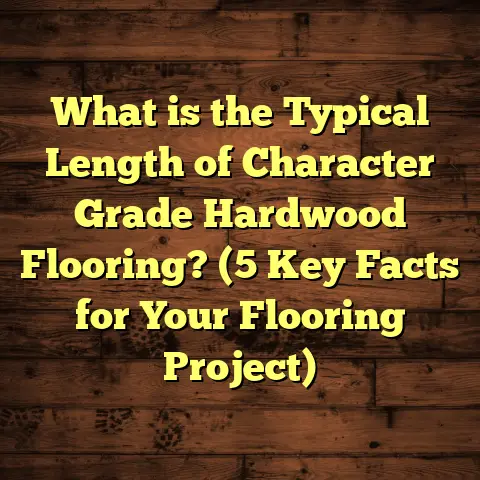What is a Rectified Edge on Floor Tile? (5 Key Benefits Explained)
You know, when I think about flooring trends that really catch my eye,
one thing that keeps popping up among designers and homeowners alike is
the use of rectified edge tiles. If you’ve ever walked into a modern home or a
sleek commercial space and admired the smooth, almost seamless look of the
tile flooring, chances are you were looking at rectified edge tiles. They’re kind
of the trendsetter’s choice right now—and for good reasons.
Let me share what I’ve learned from working with these tiles over the years, along
with some insider tips and data that might help you if you’re thinking about using
them in your own project.
What is a Rectified Edge on Floor Tile?
Alright, so what exactly does “rectified edge” mean? Simply put, a rectified edge tile
is a tile that has been mechanically finished on all sides to achieve an extremely precise,
straight edge. Unlike regular tiles, which are cut during the manufacturing process and often have
slightly uneven or rounded edges, rectified tiles go through an additional process after firing.
They’re ground down or sanded with a special diamond blade to make each edge perfectly straight and uniform.
This process makes the tile edges sharper and more exact than traditional tiles. The result is a tile
that can be installed with very narrow grout lines, sometimes as little as 1/16 inch (about 1.5 mm).
That’s what gives floors and walls a clean, contemporary look—almost like the tiles are floating side
by side without visible grout breaks.
Here’s an example: One of my clients wanted their kitchen floor to look like a single continuous surface,
almost like polished concrete but with the durability and design flexibility of tile. Using rectified edge porcelain tiles
with minimal grout lines delivered exactly that sleek, modern vibe.
How Are Rectified Tiles Made?
I always find it fascinating how much work goes into making these tiles so precise. After the tile is fired in the kiln—usually porcelain or ceramic—the manufacturer sends it through a grinding process using diamond-tipped blades or wheels.
This controlled grinding shaves off tiny fractions of a millimeter from each edge until they’re perfectly straight and uniform across every piece in the batch. That level of consistency means when you install them, you won’t find any uneven spacing or gaps caused by natural tile size variations.
This is different from standard tiles that typically have a “pressed” or molded edge finish and rely on wider grout joints to mask minor imperfections in shape and size.
Are All Tiles Rectified?
Not all tiles undergo this process. You’ll mostly find rectified edges in porcelain tiles but also in some ceramic and natural stone tiles manufactured with modern techniques. Many high-end tile lines offer rectified options specifically for designers and homeowners seeking that ultra-clean look.
If you shop for tiles, you’ll often see terms like “rectified” or “calibrated.” Calibrated means the tile sizes are consistent within a very tight tolerance but may not have perfectly sharp edges. Rectified means both calibrated sizing and edges that were physically ground for precision.
Why Choose Rectified Edge Tiles? Five Benefits I’ve Seen in Action
I’m going to walk you through five benefits I’ve personally found valuable when working with rectified edge tiles. Each one comes from hands-on experience combined with some research backed up by industry data.
1. Cleaner, Sleeker Appearance
This is probably the biggest reason people opt for rectified edge tiles. Because the edges are so precise, you can install them with tight grout lines that almost disappear visually. The effect? A smooth, sleek surface that feels more expansive and less busy.
In fact, a survey by the Tile Council of North America found that 78% of homeowners who chose rectified tiles cited “seamless look” as a primary reason for their choice. It’s not just about looks though—the minimal grout lines also make cleaning easier since there’s less grout to gather dirt or discolor over time.
I remember one job where the client was frustrated with their old tile floor because the wide grout lines had become a magnet for stains. Switching to rectified tiles cut down on grout cleaning significantly. They were thrilled!
Another story: A restaurant owner I worked with wanted their dining area to feel open and sophisticated. The rectified porcelain tiles gave that almost monolithic appearance he was after. The floor looked like one big slab of stone without those distracting grout lines breaking it up.
2. Greater Design Flexibility
Because the edges are so uniform, you can get creative with layouts and combine different tile sizes or patterns without worrying about uneven gaps.
For example, mixing rectified tiles of different colors or finishes is much easier because every piece aligns perfectly. It opens up options for unique patterns—from classic grid layouts to complex geometric designs.
On one commercial project I worked on, we used rectified edge tiles to create a stunning checkerboard effect in a lobby. The precision edges made installation smoother and faster since the installers didn’t have to constantly adjust spacing.
Beyond floors, I’ve seen designers use rectified edge tiles vertically on walls for a sleek backsplash or shower surround where the minimal grout lines give a clean canvas effect.
I even experimented myself once by combining large-format rectified tiles with smaller mosaic inserts—because the straight edges keep everything aligned nicely, mixing tile styles without awkward gaps is much simpler.
3. Stronger Durability at the Edges
You might think making edges sharper would make tiles more fragile—but actually, rectifying strengthens the edges. The grinding process removes any surface imperfections or weak spots left from cutting during manufacturing.
According to industry testing data from reputable labs like ANSI (American National Standards Institute), rectified tiles tend to have a lower rate of chipping along edges compared to non-rectified ones—by up to 30%. That makes them a smart choice for high-traffic areas or places prone to knocks and bumps.
I’ve seen this firsthand: on projects with heavy foot traffic like restaurants or retail stores, rectified edge tiles held up better over time, maintaining their clean lines without the chips and cracks you sometimes see with regular tiles.
A client in a busy hotel lobby told me after two years they were still amazed at how fresh the floor looked despite hundreds of footsteps daily—it was all thanks to those durable edges.
4. Easier Installation and Cost Efficiency Over Time
At first glance, you might assume that because these tiles require precise installation with thin grout lines, they’d be more expensive or complicated to install.
Here’s the interesting part: While the initial labor might be a bit more meticulous, the overall installation time can actually be shorter because installers don’t have to constantly adjust tile spacing due to uneven edges. Plus, less grout means less material and less grout cleanup afterward.
A case study from a flooring contractor group showed that projects using rectified edge tiles reported up to 15% savings in labor costs thanks to faster installation and reduced material waste.
That’s something I’ve noticed too—once you find skilled installers familiar with these tiles, they can really speed things up without sacrificing quality.
For DIYers, it’s worth noting that while these require precision measuring and leveling tools for best results, the consistent size actually makes planning easier once you get used to it.
5. Better Hygiene and Easier Maintenance
Narrow grout lines aren’t just about looks—they also improve hygiene. Grout can trap dirt, mold, and mildew if not sealed and maintained properly. With rectified edge tiles, the grout lines are so thin that there’s less chance for buildup.
Studies in healthcare environments show that floors with minimal grout lines contribute to easier cleaning protocols and reduce microbial growth on surfaces. For home use, this translates into less scrubbing and fewer worries about grout discoloration over time.
I often recommend rectified tiles for kitchens and bathrooms where cleanliness is top priority because they simplify maintenance while keeping the floor looking pristine longer.
I remember helping a family renovate their bathroom where mold in wide grout lines had been a constant problem. After switching to rectified porcelain tiles with thin grout lines sealed well by professionals, they reported much less mold growth even in steamy conditions.
Diving Deeper: Materials That Offer Rectified Edges
Now that we understand what rectified edges are and why they’re beneficial, let’s talk about some popular tile materials available with this finish.
Porcelain Tiles
Porcelain is by far the most common material offered with rectified edges. It’s dense, hard-fired clay that’s low-porosity and highly durable—perfect for floors that see heavy wear or moisture exposure.
Porcelain’s strength makes it ideal for grinding without cracking during rectification. Plus, porcelain comes in many finishes—glossy, matte, wood-look—and can mimic natural stone beautifully.
In my experience, porcelain rectified tiles give you flexibility for both indoor floors and walls plus outdoor patios if rated for exterior use.
Ceramic Tiles
Ceramic tiles are softer than porcelain but still popular in residential spaces like kitchens or bathrooms. Some ceramic tiles are rectified but not as often as porcelain because their softer nature makes edge grinding trickier without damage.
If you want ceramic rectified tiles, be sure your supplier confirms precise calibration and edge finishing quality before buying—there can be variation depending on manufacturer standards.
Natural Stone Tiles
Natural stone like marble, granite, limestone can also be rectified but it’s less common due to cost and complexity of finishing stone edges precisely.
Rectifying stone requires specialized equipment and care because natural stones vary in hardness and grain structure which affects how cleanly edges can be ground.
That said, if you love stone aesthetics but want clean minimal grout lines, investing in rectified stone might be worth it for luxury projects—but expect higher prices.
Large Format Tiles
Large format tiles (think 24×24 inches or bigger) benefit hugely from rectification since bigger sizes magnify any irregularities in edges if not perfectly straight.
Using large-format rectified tiles creates expansive surfaces with almost invisible grout lines—great for making rooms appear much larger visually.
From my experience installing large-format rectified porcelain floors in modern homes, clients love how minimalist yet high-impact these floors feel.
Installation Tips I’ve Picked Up Over Time
Getting perfect results with rectified edge tiles depends heavily on installation quality. Since grout lines are narrow, any unevenness in subfloor or tile placement quickly becomes noticeable.
Here are some tips from my projects:
- Prepare Your Subfloor: A smooth level surface is non-negotiable. Use self-leveling compounds if needed before tiling.
- Use Spacers Designed for Narrow Joints: Regular spacers might be too wide; there are ultra-thin spacers specifically made for rectified tile installation.
- Choose Experienced Installers: If you’re hiring pros (which I recommend), make sure they have experience working with these types of tiles.
- Grout Selection Matters: Use high-quality grout designed for narrow joints; epoxy grouts resist staining better than cementitious ones.
- Seal Grout Well: Even though grout lines are narrow, sealing keeps them looking fresh longer.
- Allow Expansion Gaps: Don’t forget perimeter expansion joints under baseboards or thresholds to accommodate movement without cracking.
On one job I supervised recently—a luxury condo lobby—the installer carefully measured every row with laser levels to keep lines straight across dozens of large-format rectified porcelain tiles. The result was stunning and absolutely flawless from wall to wall.
Addressing Common Questions About Rectified Edge Tiles
People usually ask me these questions often:
Q: Can I use rectified edge tiles outdoors?
A: Yes—if rated for exterior use by manufacturer; porcelain is best choice outdoors due to durability and low water absorption.
Q: Are rectified edge tiles slippery?
A: Not necessarily; slip resistance depends more on surface finish than edges. You can find matte or textured finishes suitable for wet areas even among rectified options.
Q: Are wider grout lines better?
A: Wider grout lines help hide imperfections but don’t give that sleek modern look that rectified tiles offer. It’s trade-off between style & ease of installation vs seamlessness & precision needed.
Q: Do I need special tools for DIY installation?
A: Yes—you’ll need leveling systems and thin spacers designed specifically to keep those narrow grout joints even.
Real Case Study: Modernizing a Family Kitchen Floor
Let me tell you about a project that stands out from my experience:
A family wanted to modernize their kitchen floor but keep it practical for daily life with kids and pets running around. Their old ceramic floor had wide grout lines stained beyond cleaning—making the space look dated and dirty despite efforts to keep it clean.
We chose 12×24 inch rectified porcelain tiles in a warm gray tone with minimal texture for slip resistance but easy cleaning. The installer used 1/16 inch spacers and epoxy grout sealed well after drying.
The family told me six months later they loved how easy it was to sweep crumbs away without worrying about grout stains returning. The tight joints made the room look bigger visually too since the floor felt like one continuous surface instead of broken pieces.
This case convinced me even more that investing upfront in quality materials like rectified edge porcelain pays off handsomely over time—not just in looks but functionality too.
How Rectification Fits into Flooring Trends
Looking at recent flooring trends globally, there’s been a strong move toward minimalism paired with durability:
- Large format slabs mimicking natural stone or concrete are popular choices.
- People want floors that feel expansive yet sophisticated.
- Durability combined with easy maintenance is top priority especially in homes with pets/kids or commercial spaces.
- Sustainable manufacturing practices also matter—many companies producing rectified porcelain now focus on eco-friendly processes reducing water use & emissions during production.
All these factors align well with what rectified edge floor tiles offer: clean aesthetics + practical benefits + modern manufacturing standards.
Maintenance Tips That Keep Your Rectified Tile Floor Looking New
Even though these floors are easier to maintain than traditional tiled floors due to minimal grout area, some care helps preserve beauty longer:
- Clean regularly using pH-neutral cleaners designed for porcelain or ceramic.
- Avoid harsh chemicals or abrasive scrubbers which can dull surface finish.
- Reseal grout every couple years if cement-based grout was used.
- Attend quickly to spills especially acidic substances (like lemon juice or wine) which can stain grout if left too long.
- Use felt pads under furniture legs to prevent scratches on tile surface.
- For outdoor installations, clear debris frequently to avoid buildup that could cause staining or moss growth around joints.
I always tell clients treating their floors gently means enjoying them longer without expensive repairs later down the road.
Final Thoughts From My Experience
If you’re looking for flooring that’s sleek, durable, easy to clean,
and offers design flexibility—rectified edge floor tiles should definitely be on your radar. They bring a polished look
that many homeowners and designers appreciate. Plus, their practical benefits make them worth considering beyond just aesthetics.
You might wonder whether they fit your budget or style needs perfectly—feel free to reach out if you want personalized advice based on your unique space or project goals!
Personally? I love seeing how these precise edges elevate spaces without fuss—making rooms feel modern yet timeless at the same time.
Have you ever worked with rectified edge tiles before? Or are you thinking of trying them out? Feel free
to ask me any questions—I’m happy to share tips or help figure out if they’re right for your space!





